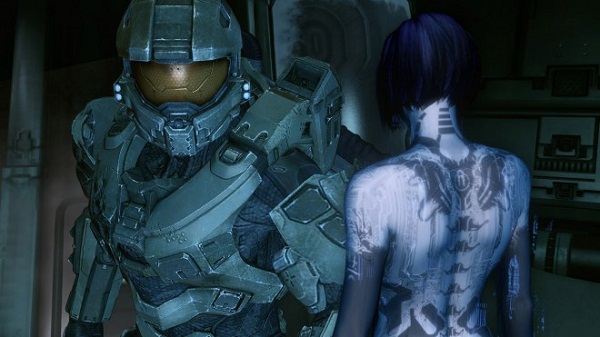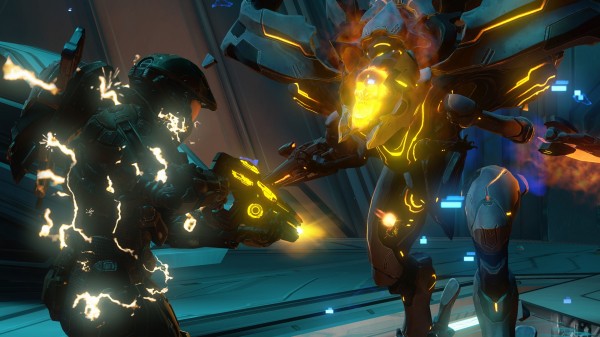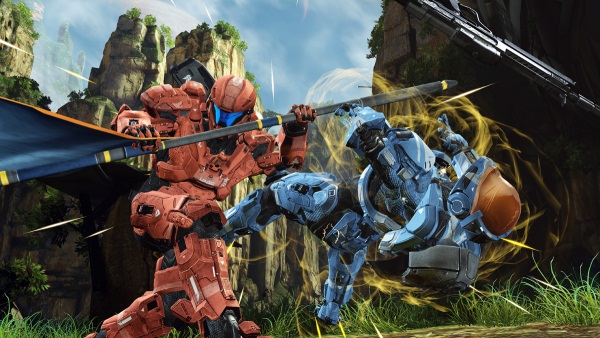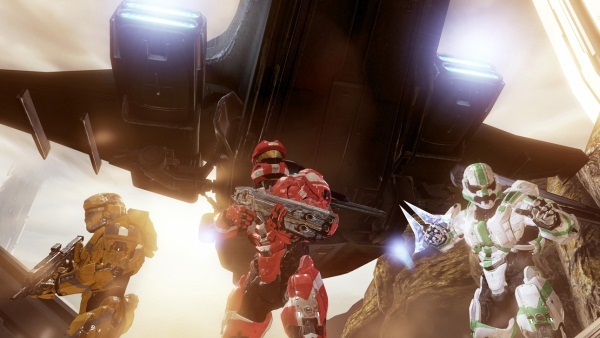It’s been a long time since gamers last saw Master Chief. Halo 4 arrives five years after the conclusion of the series’ original trilogy, and a lot has happened in that time. The franchise is now under new management – 343 Industries – and modern military shooters have dominated the FPS genre. But despite his absence, the Chief still isn’t one to go down so easily. 343 has learned what works, both in its competitor’s titles and in previous Halo games, and has used that knowledge to create what is the best game Halo has to offer since John-117 first stepped out of cyro-sleep in Combat Evolved.
One of the things Halo prides itself on is a strong narrative to complement its multiplayer offerings. While I personally enjoyed the campaigns of Halo 2 and Halo 3, Halo 4’s single-player experience made them feel dull in comparison. The big set-pieces those two titles made famous are still there, but thanks to the Forerunner planet of Requiem, that sense of discovery and wonderment from Combat Evolved has also returned. 343 also takes it even further by making Halo 4 a far more personal tale than previously experienced, even more so than ODST and Reach.

With Cortana in her eighth year of life, she’s beginning to fall victim to rampancy, which is essentially the AI version of dementia. In order to save her, Master Chief needs to find a way off Requiem and back to Earth before Cortana literally thinks herself to death. This urgent issue allowed me to explore the duo’s relationship on a deeper level than ever before and probe deep at the question of just which is the human and which is the robot.
Up until now, Chief has just been a tough-as-nails, do-as-told soldier reminiscent of 80’s action flick protagonists. Now I’m finally starting to see him grow, evolve, and earn an actual identity. It’s a great step forward for the franchise that separates it from typical FPS campaign tropes.
In order to keep campaign combat from getting stale, players are introduced to a brand new enemy force in Halo 4, the Prometheans. Essentially advanced sentinels created by the Forerunners, they are the protectors of Requiem and its dark secrets. These groups of four-legged crawlers, bipedal knights, and hovering watchers add a nice change of pace from classic Covie-killing and bring an extra challenge tinted by their infused narrative role.
The challenge is emphasized by the game’s added difficulty level. Heroic and Legendary have both been beefed up, where knowing what weapons work best against which foes, when to take cover, and the order in which enemies need to be dispatched is mandatory for success. This made the first three campaign missions excruciatingly tough for me, but once I started using my head and taking what I’d learned into the conflicts, I found them to be far more manageable and satisfying.

With the old engine worn by the time of Reach’s release, I was amazed at just how good Halo 4’s new engine looked. I actually had a difficult time believing that what I was playing was running on a seven-year-old console. The in-game detail is phenomenal, while facial animations in cutscenes are the best I’ve seen since L.A. Noire, if not better. This is, without a doubt, the best visual presentation I’ve seen on the Xbox 360.
Audio has also been a big deal to the Halo franchise since Halo 2, and this latest approach blew my mind with its quality. Guns have a crisp bark, each distinct, so I knew what an enemy was carrying and could determine a proper method of attack. Another audio standout was the game’s voice acting, particularly Jen Taylor as Cortana and series newcomer Darren O’Hare as Thomas Lasky. It’s because of Taylor that Cortana’s plight seems so dire and made me forget she was an AI, while O’Hare makes Lasky an incredibly likable sidekick. Steve Downes does an admirable job as Master Chief, but doesn’t really shine until the game’s closing chapters.
While Halo’s developers have taken pride in its campaign, it’s the multiplayer that serves as the series’ bread and butter. 343 has made a fair share of tweaks to the competitive side – known as War Games – that create what could best be described as a merger of Reach and Call of Duty. Players will have their loadouts like in Reach, but they will now feature tactical packages and support upgrades (i.e. perks) in addition to the standard primary weapon, secondary weapon, grenade, and armor ability options. These create a more diverse playing field and allow gamers to tailor their experience to their distinct styles. Personally, I have a tendency to reload often, so I found the Dexterity tactical package that hastens my reload and weapon swapping speed to be of great assistance.

As in the modern military shooters with which the game competes, Halo 4 players gradually unlock more custom loadouts and weapons as they level, and also earn bonuses, called ordinances, with points rewarded for everything from kills to objective completion. Importantly, the systems in place here don’t make the actual competitions uneven. As with all Halo games, those with skill, communication, and proper strategy can beat just about anyone regardless of what they’re packing. Plus, the action is still true to the series’ roots, established by Bungie. High jumping, assassinations, medals upon medals, tons of unlockable armor pieces, commendations, and more are still there. Instead of being a hideous monstrosity without its own identity, 343 has instead meshed the best of both worlds. It all comes together and works to perfection.
Other modes like Forge and Theater make a return as well in the game’s multiplayer suite with all the bells and whistles that have been there before. The game’s new co-op mode, Spartan Ops, instead offers a whole new and interesting way to play online with friends. Buddies aren’t necessary for the mode, but it’s encouraged and much easier.

Set six months after the ending of the campaign, Spartan Ops casts players in the role of Crimson Squad, a Spartan fire team scouring Requiem for artifacts and knowledge that can help them to better understand the Forerunners and their technology. There are a few new locales here, but some are taken straight from the campaign, which feels a bit lazy. Players also respawn upon death with no reversion to a checkpoint, so there is almost no danger of failure. Certain secondary objectives can be a bit tough to take on in the higher difficulties, but they’re not needed to beat the mode’s chapters. Despite the relative ease of Spartan Ops, the mode is still fun. Each episode’s introductory cutscene adds more to the story, and players earn medals, points, and commendations to keep their Spartans leveling.
While the Chief has been out of the fight for quite a while, it’s clear that under the direction of 343 Industries, he remains a force in the gaming universe. Halo 4 could have been a total disaster, ruining a cherished franchise and enraging fanboys across the world. Instead, it has become the series’ new high point. An engaging campaign, incredible sound design, a beautiful new engine, and an addictive multiplayer suite are just some of the reasons why this is the best Halo yet. It may even be the best game of the year.
Welcome home, Chief. You’ve been missed.


















